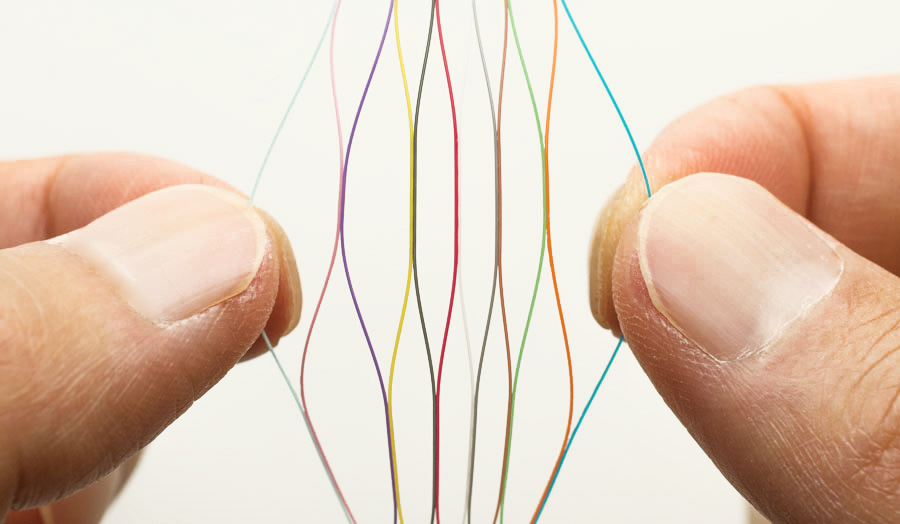High-Speed Data Transmission Solutions
Unlock the Power of Multimode Fiber
Our premium multimode optical fibers and cables are designed to provide reliable, low-power and high-bandwidth connections for a variety of short-reach applications including:
- Cloud, Edge and Enterprise Data Centers
- Artificial Intelligence / Machine Learning Clusters
- Local Area Networks
- Storage Area Networks
- Equipment Rooms
- Central Offices
Multimode Fibers and VCSEL Technology
Short-reach solutions combining multimode cabling and VCSEL-based transceiver technology have been widely deployed due to their proven advantages in cost, power consumption and reliability. OFS with its AT&T Bell Labs heritage has been at the forefront of the multimode fiber industry, playing a key role in the development of laser-optimized OM3 and OM4 multimode fibers, and innovating premium OM4+ and OM5 multimode fibers designed for multiple wavelength transmission. Through relentless focus on manufacturing excellence, we continue to improve the specifications and quality of our multimode fibers to offer the most reliable user experience.
LaserWave Multimode Solutions: Better Fiber for Better Connections
The LaserWave Optical Fiber family offers comprehensive industry-leading quality and specifications:
Most Stringent DMD Bandwidth Specifications: Exceeding both EMB and Mask Width grading techniques to deliver reliable system performance.
- Specification Enhancements: Read the FAQ >>
Tightest Glass Geometry and NA Tolerances for Ultra-Low-Loss Connections: Reliable connectivity performance is crucial for short-reach solutions. Through excellence in process control we’ve tightened our LaserWave fiber geometry and NA specifications to deliver ultra-low-loss connections, further improving system robustness and reliability.
- Multimode Effects on Connector Insertion Loss: Read the White Paper >>
Exceptional Attenuation and Microbend Sensitivity: OFS multimode fiber has the lowest 850nm attenuation in the industry and is complimented by our patented D-Lux® Shield coating process that provides exceptional protection against microbend losses experienced during cabling. The result is that our premium multimode fibers achieve extremely low attenuation in existing cable designs and unlock new high-density multimode cables designs that were previously not possible.
- Improved Geometry for LaserWave Multimode Fibers: Read Press Release >>
LaserWave Multimode Rollable Ribbon Cables
Ultra-Compact Data Center Cables
Improvements to the microbend sensitivity of OFS LaserWave fiber have unlocked Multimode Rollable Ribbon Solutions for high-density multi-fiber interconnects (E.g., 400G SR4, 800G SR8).
- Partially bonded ribbon
- Rolls into a cylinder
- Higher density than flat ribbons
- Enables ribbon splicing
- Ideal for multi-fiber connectors
Compact and lightweight R-Pack™ Backbone Fiber Optic Cables are plenum (12-72 fiber) or dual rated (Riser/CPR 12-144 fiber) for use in demanding building applications.
Higher fiber counts are available in AccuRiser I/O Dual-Rated Fiber Optic Cables (Riser and LSZH/CPR 144-864 fibers). AccuRiser cables simplify transitions from outdoor to indoor use and feature a dual flame rating for universal use throughout much of the world.

Rollable Ribbon Fiber
OM3 / OM4
- Exceptional Fiber Quality: Industry-leading fiber geometry and optical parameters
- High-Speed Capabilities: Supports network speeds to 800 Gb/s and beyond
- Improved Macrobend Performance: Better macrobend performance enables better space utilization and more compact designs, while facilitating jumper MACs
- Enhanced Network Flexibility: Supports added network flexibility
OM4+
- Dual-Band Performance: It offers OM5-equivalent performance between 850nm and 910nm wavelengths, supporting bidirectional transmission and maintaining a 100m reach for Terabit Ethernet applications
- Cost-Effective: Positioned between OM4 and OM5, it provides a cost-effective solution for BiDi applications without supporting the full SWDM4 range up to 953nm
- Compatibility: It is fully backward compatible with OM4 standards and applications, ensuring seamless integration with existing infrastructure
OM5
- High-Speed Data Transmission: Supports today’s applications including 100/200/400/800 Gb/s Ethernet and 32/64 GFC
- Future-Proofing: Ready for next-generation wideband networks
- Optimized Performance: Optimized for 100 Gb/s duplex (two fiber) transmission using BiDi and SWDM4 applications

Choosing Between Single-Mode vs Multimode Fibers
Compared to single-mode, multimode fiber continues to be the more cost-effective and lowest power consumption fiber for short-reach applications (< 500 meters) due to generally cheaper and less power-hungry 850 nm VCSEL-based optics. The OFS LaserWave family of OM3, OM4 and OM5 multimode fibers support application speeds ranging from 10 Gb/s all the way to 400 Gb/s and beyond. LaserWave WideBand OM5 fiber offers extended reach for multi-wavelength WDM applications, including current and future BiDi and SWDM4 solutions, making it the most future-proof solution.
One of the most important multimode fiber parameters is bandwidth, which defines the information-carrying capacity of the fiber. OFS has led the way in developing and standardizing new and innovative ways to maximize and characterize fiber bandwidth for reliable system performance.
Multimode Fiber Frequently Asked Questions (FAQ)
How does multimode fiber work?
Multimode fiber continues to evolve, supporting the latest network speeds in enterprise and data center networks. Multimode technology has maintained its ability to provide the most cost-effective short reach links through a combination of fiber and optical component development that takes advantage of technology advances. Fiber bandwidth is a critical component of this equation.
What is multimode fiber used for?
Multimode optical fiber systems continue to be the most cost-effective fiber choice for shorter reach premises, campus, enterprise LAN networks, and data center applications, up to 500 – 600-meter range. This is because multimode optics continues to be less expensive than single-mode optics. Beyond the reach of multimode optical fibers, it becomes necessary to use single-mode optical fiber.
What is the difference between single-mode and multimode fiber?
The way in which these two fiber types transmit light eventually led to their separate names. Generally designed for systems of moderate to long-distance (e.g., metro, access, and long-haul networks), single-mode optical fibers have a small core size (< 10 µm) that permits only one mode or ray of light to be transmitted. This tiny core requires precision alignment to inject light from the transceiver into the core, significantly driving up transceiver costs.
Multimode optical fibers have larger cores that guide many modes simultaneously. The larger core makes it much easier to capture light from a transceiver, allowing source costs to be controlled. Similarly, multimode connectors cost less than single-mode connectors as a result of the more stringent alignment requirements of single-mode optical fiber.
What is the maximum distance for multimode fiber?
Reach of multimode fiber is dependent on the data rate and transceivers used. Industry standards define reaches at given data rates with given transceivers. For example:
- 2 kms at 100 Mb/s (100BASE-FX)
- 1 km at 1 Gb/s (1000BASE-SX)
- 400 – 600 m at 10 Gb/s (10GBASE-S)
- 70 – 150 m at data rates ranging from 40 to 400 Gb/s.
Transceiver manufacturers offer extended reach transceivers to achieve even longer lengths, avoiding the need to use more expensive single-mode optics. In general, multimode optical fiber continues to be the most cost-effective choice for short reach applications.
What is OM3, OM4, and OM5 multimode fiber?
50 µm laser-optimized multimode (OM3, OM4, and OM5) optical fibers offer significant bandwidth and reach advantages for short-reach applications while preserving the low system cost advantages of multimode optical fiber.
Today, 62.5 µm OM1 multimode optical fiber is virtually obsolete and is relegated for use with extensions or repairs of legacy, low bandwidth systems. 62.5 µm OM1 fiber supports only 33 meters at 10G, and is not even recognized as an option for faster speeds.
Why OM5 Wideband?
WideBand OM5 Multimode Fiber is a 50 micron (μm) laser-optimized multimode fiber designed to help meet the demanding requirements of today’s 850 nm based networks, as well as next-generation multimode short wavelength division multiplexing (SWDM) applications. OFS’ LaserWave WideBand OM5 fiber is designed to support light traveling at multiple wavelengths from 850 nm to 953 nm, unlike OM3 and OM4 fibers that are optimized for single wavelength, 850 nm operation.
- Wideband OM5 FAQ
- White Paper: Award-Winning LaserWave® FLEX WideBand Multimode Optical Fiber
- White Paper: Multimode or Single-mode Fiber?
- LaserWave® WideBand (OM5) Fiber One Page Overview
- FAQ on OM5 WideBand Fiber

